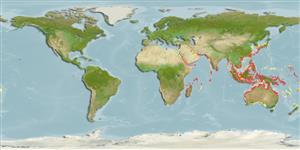ກຸ່ມປາກະດູກອ່ອນ (ເຊັ່ນ: ປາສະຫລາມ, ປາຜາໄລ) (sharks and rays) >
Myliobatiformes (Stingrays) >
Rhinopteridae (Cownose rays)
Etymology: Rhinoptera: Greek, rhinos = nose + Greek,pteron = fin, wing (Ref. 45335).
More on authors: Müller & Henle.
Environment: milieu / climate zone / depth range / distribution range
ນິເວດວິທະຍາ
ສັດທະເລ; ນ້ຳກ່ອຍ ກ່ຽວກັນຫີນ. Tropical; 30°N - 15°S, 55°E - 135°E (Ref. 114953)
Indo-West Pacific: Oman to the Philippines; north to Ryukyu Is.; south to eastern Indonesia.
ຂະໜາດ / ນ້ຳໜັກ / Age
Maturity: Lm ? range ? - ? cm
Max length : 165 cm WD ຕົວຜູ້/ບໍ່ມີເພດ; (Ref. 114953); ນ້ຳໜັກສູງສຸດທີ່ເຄຍຈັດພີມມາ: 4.5 kg (Ref. 3965)
Double-lobed snout and indented forehead; jaws usually with 7 rows of plate-like teeth; no caudal fin (Ref. 5578). Brown above, white below (Ref. 5578).
Found in bays, estuaries, and near coral reefs (Ref. 12951), over sand and mud bottoms (Ref. 9710). Usually solitary or in small aggregations (Ref. 114953). However, large schools with up to 500 individuals have been reported (Ref. 12951). Feeds on clams, oysters and crustaceans (Ref. 12951). Lives to over 2 years in captivity (Ref. 12951). Ovoviviparous (Ref. 50449). Edible (Ref. 30573). Caught mainly by gill net fisheries (Ref. 114953), occasionally by bottom trawl, demersal inshore gillnet and tangle net fisheries. Utilized for its meat (Ref. 58048).
Life cycle and mating behavior
ການຈະເລີນເຕັມໄວ | ການສືບພັນ | ການວາງໄຂ່ | ໄຂ່ | ຄວາມດົກຂອງໄຂ່ປາ | ຕົວອ່ອນ
Males court by nipping the female's dorsum. Mating pair orient in a venter to venter position, and the male inserts one or both claspers. The pair usually rests on the substrate, with the female on top of the male. Mating lasts about 30 seconds (Ref. 12951) to 1 minute (Ref. 49562). Exhibit ovoviparity (aplacental viviparity), with embryos feeding initially on yolk, then receiving additional nourishment from the mother by indirect absorption of uterine fluid enriched with mucus, fat or protein through specialised structures (Ref. 50449). Size at birth ~60 cm WD. One large pregnant female (~130 cm WD) contained a single late-term embryo 61 cm WD (Ref.58048).
Last, P.R., W.T. White, M.R. de Carvalho, B. Séret, M.F.W. Stehmann and G.J.P. Naylor, 2016. Rays of the world. CSIRO Publishing, Comstock Publishing Associates. i-ix + 1-790. (Ref. 114953)
IUCN Red List Status (Ref. 130435)
Human uses
ການປະມົງ: ເປັນສີນຄ້າ; ຊະນິດປາທີ່ຖືກນຳໃຊ້ເຂົ້າໃນການຫາເພື່ອເປັນເກມກິລາ: ແມ່ນ
ຂໍ້ມູນຕື່ມອີກ
ເອກະສານອ້າງອີງການລ້ຽງສັດນ້ຳຂໍ້ມູນການລ້ຽງສັດນ້ຳສາຍພັນກຳມະພັນElectrophoresesການຖ່າຍທອດທາງກຳມະພັນຈາກພໍ່ແມ່ຫາລູກພະຍາດການປຸງແຕ່ງNutrientsMass conversion
ເຄື່ອງມື
Special reports
Download XML
ແຫຼ່ງອີນເຕີເນັດ
Estimates based on models
Preferred temperature (Ref.
123201): 24.2 - 29.2, mean 28.4 °C (based on 3123 cells).
Phylogenetic diversity index (Ref.
82804): PD
50 = 0.5039 [Uniqueness, from 0.5 = low to 2.0 = high].
Bayesian length-weight: a=0.01122 (0.00647 - 0.01946), b=2.94 (2.78 - 3.10), in cm total length, based on LWR estimates for this species & (Sub)family-body (Ref.
93245).
ຊັ້ນເຂດຮ້ອນ (Ref.
69278): 3.5 ±0.24 se; based on food items.
ຄວາມຢືດຢຸ່ນ (Ref.
120179): ຕຳ່ຫຼາຍ, ປະຊາກອນຕຳ່ສຸດທີ່ໃຊ້ເວລາສອງເທົ່າຫຼາຍກວ່າ 14 ປີ (Fec=1-2).
Fishing Vulnerability (Ref.
59153): Very high vulnerability (85 of 100).
Nutrients (Ref.
124155): Calcium = 5.55 [0.68, 83.89] mg/100g; Iron = 0.366 [0.030, 4.005] mg/100g; Protein = 20.9 [15.6, 26.2] %; Omega3 = 0.0676 [, ] g/100g; Selenium = 30.8 [5.7, 156.0] μg/100g; VitaminA = 18.7 [1.7, 205.1] μg/100g; Zinc = 0.824 [0.056, 9.302] mg/100g (wet weight);
